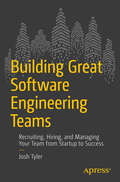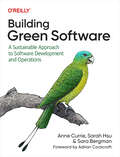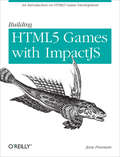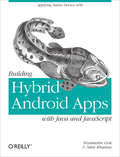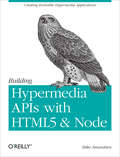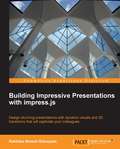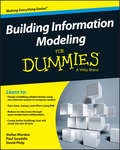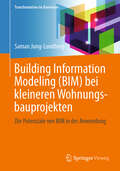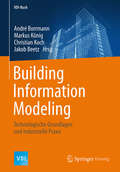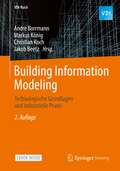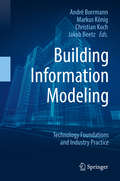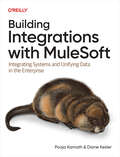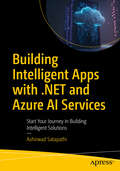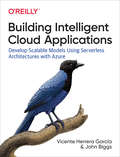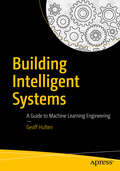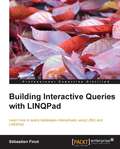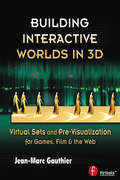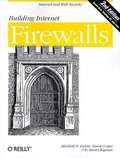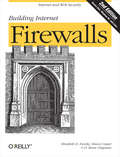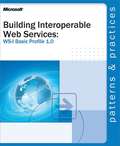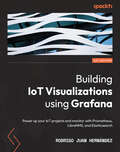- Table View
- List View
Building Great Software Engineering Teams: Recruiting, Hiring, and Managing Your Team from Startup to Success
by Josh TylerWINNER of Computing Reviews 20th Annual Best Review in the category Management “Tyler’s book is concise, reasonable, and full of interesting practices, including some curious ones you might consider adopting yourself if you become a software engineering manager.” —Fernando Berzal, CR, 10/23/2015 “Josh Tyler crafts a concise, no-nonsense, intensely focused guide for building the workhouse of Silicon Valley—the high-functioning software team.” —Gordon Rios, Summer Book Recommendations from the Smartest People We Know—Summer 2016Building Great Software Engineering Teams provides engineering leaders, startup founders, and CTOs concrete, industry-proven guidance and techniques for recruiting, hiring, and managing software engineers in a fast-paced, competitive environment.With so much at stake, the challenge of scaling up a team can be intimidating. Engineering leaders in growing companies of all sizes need to know how to find great candidates, create effective interviewing and hiring processes, bring out the best in people and their work, provide meaningful career development, learn to spot warning signs in their team, and manage their people for long-term success.Author Josh Tyler has spent nearly a decade building teams in high-growth startups, experimenting with every aspect of the task to see what works best. He draws on this experience to outline specific, detailed solutions augmented by instructive stories from his own experience. In this book you’ll learn how to build your team, starting with your first hire and continuing through the stages of development as you manage your team for growth and success. Organized to cover each step of the process in the order you’ll likely face them, and highlighted by stories of success and failure, it provides an easy-to-understand recipe for creating your high-powered engineering team.
Building Green Software: A Sustainable Approach to Software Development and Operations
by Anne Currie Sarah Hsu Sara BergmanHow will software development and operations have to change to meet the sustainability and green needs of the planet? And what does that imply for development organizations? In this eye-opening book, sustainable software advocates Anne Currie, Sarah Hsu, and Sara Bergman provide a unique overview of this topic—discussing everything from the likely evolution of national grids to the effect those changes will have on the day-to-day lives of developers.Ideal for everyone from new developers to CTOs, Building Green Software tackles the challenges involved and shows you how to build, host, and operate code in a way that's not only better for the planet but also cheaper and relatively low-risk for your business. Most hyperscale public cloud providers have already committed to net-zero IT operations by 2030. This book shows you how to get on board.You'll explore:How the energy transition is likely to change hosting on prem and in the cloud—and how your company can prepareThe fundamental architectural principles of sustainable software development and how to apply themHow to determine which parts of your system need to changeThe concept of extending hardware longevity and the part that software plays
Building HTML5 Games with ImpactJS: An Introduction On HTML5 Game Development
by Jesse FreemanCreate a real 2D game from start to finish with ImpactJS, the JavaScript game framework that works with the HTML5's Canvas element. Making video games is hard work that requires technical skills, a lot of planning, and—most critically—a commitment to completing the project. With this hands-on guide, you’ll learn how to use Impact with other technologies step-by-step.You’ll pick up important tips about game design, and discover how to publish Impact games to the Web, desktop, and mobile—including a method to package your game as a native iOS app. Packed with screen shots and sample code, this book is ideal for game developers of all levels.Set up your development environment and discover Impact’s advantagesBuild a complete game with core logic, collision detection, and player and monster behaviorLearn why a game design document is critical before you start buildingDisplay and animate game artwork with sprite sheetsAdd sound effects, background music, and textCreate screens to display stats and in-game statusPrepare to publish by baking your game files into a single file
Building Hawaii’s Innovation Economy: Summary of a Symposium
by Charles W. WessnerResponding to the challenges of fostering regional growth and employment in an increasingly competitive global economy, many U. S. states and regions have developed programs to attract and grow companies as well as attract the talent and resources necessary to develop innovation clusters. These state and regionally based initiatives have a broad range of goals and increasingly include significant resources, often with a sectoral focus and often in partnership with foundations and universities. These are being joined by recent initiatives to coordinate and concentrate investments from a variety of federal agencies that provide significant resources to develop regional centers of innovation, business incubators, and other strategies to encourage entrepreneurship and high-tech development. Building Hawaii's Innovation Economy: Summary of a Symposium explains the study of selected state and regional programs in order to identify best practices with regard to their goals, structures, instruments, modes of operation, synergies across private and public programs, funding mechanisms and levels, and evaluation efforts. This report reviews selected state and regional efforts to capitalize on federal and state investments in areas of critical national needs. Building Hawaii's Innovation Economy also reviews efforts to strengthen existing industries as well as specific new technology focus areas such as nanotechnology, stem cells, and energy in order to better understand program goals, challenges, and accomplishments.
Building High Integrity Applications with Spark
by John W. Mccormick Peter C. ChapinSoftware is pervasive in our lives. We are accustomed to dealing with the failures of much of that software - restarting an application is a very familiar solution. Such solutions are unacceptable when the software controls our cars, airplanes and medical devices or manages our private information. These applications must run without error. SPARK provides a means, based on mathematical proof, to guarantee that a program has no errors. SPARK is a formally defined programming language and a set of verification tools specifically designed to support the development of software used in high integrity applications. Using SPARK, developers can formally verify properties of their code such as information flow, freedom from runtime errors, functional correctness, security properties and safety properties. Written by two SPARK experts, this is the first introduction to the just-released 2014 version. It will help students and developers alike master the basic concepts for building systems with SPARK.
Building Hybrid Android Apps with Java and JavaScript: Applying Native Device APIs
by Nizamettin Gok Nitin KhannaBuild HTML5-based hybrid applications for Android with a mix of native Java and JavaScript components, without using third-party libraries and wrappers such as PhoneGap or Titanium. This concise, hands-on book takes you through the entire process, from setting up your development environment to deploying your product to an app store.Learn how to create apps that have access to native APIs, such as location, vibrator, sensors, and the camera, using a JavaScript/Java bridge—and choose the language that gives you better performance for each task. If you have experience with HTML5 and JavaScript, you’ll quickly discover why hybrid app development is the wave of the future.Set up a development environment with HTML, CSS, and JavaScript toolsCreate your first hybrid Android project, using Eclipse IDEUse the WebView control to host your hybrid applicationExplore hybrid application architecture, including JavaScript/Java communicationBuild single-page applications, using JavaScript libraries such as Backbone and UnderscoreGet optimization tips and useful snippets for CSS, DOM, and JavaScriptDistribute your application to Google Play and the Amazon Appstore
Building Hypermedia APIs with HTML5 and Node: Creating Evolvable Hypermedia Applications (Oreilly And Associate Ser.)
by Mike AmundsenWith this concise book, you’ll learn the art of building hypermedia APIs that don’t simply run on the Web, but that actually exist in the Web. You’ll start with the general principles and technologies behind this architectural approach, and then dive hands-on into three fully-functional API examples.Too many APIs rely on concepts rooted in desktop and local area network patterns that don’t scale well—costly solutions that are difficult to maintain over time. This book shows system architects and web developers how to design and implement human- and machine-readable web services that remain stable and flexible as they scale.Learn the H-Factors for representing application metadata across all media types and formatsUnderstand the four basic design elements for authoring hypermedia typesConvert a simple read-only XML-based media type into a successful API designExamine the challenges and advantages of designing a hypermedia type with JSONUse HTML5’s rich set of hypermedia controls in the API design processLearn the details of documenting, publishing, and registering media type designs and link-relation types
Building Impressive Presentations with Impress.js
by Rakhitha Nimesh RatnayakeThis book gives you exactly what you need, exactly when you need it. Using easy-to-follow practical examples, this guide takes you from simple presentations to complete websites in no time.If you want to engage your audience on a level not previously possible on software such as PowerPoint or Prezi, then this book is for you. With basic knowledge of HTML, CSS, and JavaScript you can start making presentations that truly Impress.
Building Information Modeling For Dummies
by Stefan Mordue Paul Swaddle David PhilpEverything you need to make the most of building information modeling If you're looking to get involved in the world of BIM, but don't quite know where to start, Building Information Modeling For Dummies is your one-stop guide to collaborative building using one coherent system of computer models rather than as separate sets of drawings. Inside, you'll find an easy-to-follow introduction to BIM and hands-on guidance for understanding drivers for change, the benefits of BIM, requirements you need to get started, and where BIM is headed. The future of BIM is bright—it provides the industry with an increased understanding of predictability, improved efficiency, integration and coordination, less waste, and better value and quality. Additionally, the use of BIM goes beyond the planning and design phase of the project, extending throughout the building life cycle and supporting processes, including cost management, construction management, project management, and facility operation. Now heavily adopted in the U.S., Hong Kong, India, Singapore, France, Canada, and countless other countries, BIM is set to become a mandatory practice in building work in the UK, and this friendly guide gives you everything you need to make sense of it—fast. Demonstrates how BIM saves time and waste on site Shows you how the information generated from BIM leads to fewer errors on site Explains how BIM is based on data sets that describe objects virtually, mimicking the way they'll be handled physically in the real world Helps you grasp how the integration of BIM allows every stage of the life cycle to work together without data or process conflict Written by a team of well-known experts, this friendly, hands-on guide gets you up and running with BIM fast.
Building Information Modeling: DIe Potenziale von BIM in der Anwendung (Transformation im Bauwesen)
by Prof. Dr.-Ing Jung-LundbergDie Notwendigkeit zur Applikation digitaler Methoden im Bauwesen wie Building Information Modeling (BIM) ist in den vergangenen Jahren erkannt worden. Baumaßnahmen sollen zukünftig erst virtuell und dann real gebaut werden. In diesem Kontext wurden in Deutschland bereits diverse BIM – Pilotprojekte durchgeführt. Im Fokus stehen dabei bislang primär Großprojekte. Für die angestrebte Digitalisierung der Baubranche sind jedoch auch die alltäglichen kleineren Projekte zu betrachten. Um eine Prüfung des potenziellen Nutzens von Building Information Modeling in dieser Sparte des Bauwesens zu ermöglichen, hat der Autor bereits 2019 ein entsprechendes Bewertungsmodell entwickelt. Dieses Fachbuch ist inhaltlich auf die Anwendbarkeit von BIM im Bereich ebensolcher Bauprojekte ausgerichtet. Es werden die wichtigsten Informationen zu BIM dargestellt. Anschließend werden anhand eines Praxisprojekts, welches parallel konventionell und BIM-basiert geplant wird, die Vorteile der BIM-Anwendung in kleineren Wohnungsbauvorhaben analysiert. Das Buch richtet sich an Ingenieure und Architekten in kleineren Planungsbüros und an alle BIM interessierten Akteure der Bauwirtschaft.
Building Information Modeling: Technologische Grundlagen und industrielle Praxis (VDI-Buch)
by André Borrmann Markus König Christian Koch Jakob BeetzBuilding Information Modeling (BIM) ist in aller Munde. Diese innovative Technologie, die auf der durchg#65533;ngigen Verwendung digitaler Bauwerksmodelle beruht, ist dabei, die Planungs-, Ausf#65533;hrungs- und Betriebsprozesse im Bauwesen grundlegend zu revolutionieren. Das Buch erl#65533;utert ausf#65533;hrlich die informationstechnischen Grundlagen der BIM-Methode und vermittelt dem Leser fundiertes Wissen zu allen wesentlichen Aspekten. Das gro#65533;e Potential der BIM-Methode wird durch zahlreiche erfolgreiche Anwendungsbeispiele aus der industriellen Praxis belegt, die im Buch detailliert geschildert werden.
Building Information Modeling: Technologische Grundlagen und industrielle Praxis (VDI-Buch)
by André Borrmann Markus König Christian Koch Jakob BeetzBuilding Information Modeling (BIM) ist eine innovative Technologie, die auf der durchgängigen Verwendung digitaler Bauwerksmodelle für alle Planungs-, Ausführungs- und Betriebsprozesse beruht. Das Buch erläutert ausführlich die informationstechnischen Grundlagen der BIM-Methode und vermittelt dem Leser fundiertes Wissen zu allen wesentlichen Aspekten. Die stark überarbeitete zweite Auflage geht ausführlich auf neuste Entwicklungen, u. a. im Bereich der Ausarbeitungsgrade, der BIM-Rollen und der Standardisierung ein und gibt einen vertieften Einblick in die erfolgreiche Einführung von BIM bei namhaften Auftraggebern, Planungsbüros und Bauunternehmen.
Building Information Modeling: Technology Foundations and Industry Practice (VDI-Buch)
by André Borrmann Markus König Christian Koch Jakob BeetzBuilding Information Modeling (BIM) refers to the consistent and continuous use of digital information throughout the entire lifecycle of a built facility, including its design, construction and operation. In order to exploit BIM methods to their full potential, a fundamental grasp of their key principles and applications is essential. Accordingly, this book combines discussions of theoretical foundations with reports from the industry on currently applied best practices.The book’s content is divided into six parts: Part I discusses the technological basics of BIM and addresses computational methods for the geometric and semantic modeling of buildings, as well as methods for process modeling. Next, Part II covers the important aspect of the interoperability of BIM software products and describes in detail the standardized data format Industry Foundation Classes. It presents the different classification systems, discusses the data format CityGML for describing 3D city models and COBie for handing over data to clients, and also provides an overview of BIM programming tools and interfaces. Part III is dedicated to the philosophy, organization and technical implementation of BIM-based collaboration, and discusses the impact on legal issues including construction contracts. In turn, Part IV covers a wide range of BIM use cases in the different lifecycle phases of a built facility, including the use of BIM for design coordination, structural analysis, energy analysis, code compliance checking, quantity take-off, prefabrication, progress monitoring and operation. In Part V, a number of design and construction companies report on the current state of BIM adoption in connection with actual BIM projects, and discuss the approach pursued for the shift toward BIM, including the hurdles taken. Lastly, Part VI summarizes the book’s content and provides an outlook on future developments.The book was written both for professionals using or programming such tools, and for students in Architecture and Construction Engineering programs.
Building Integrations with MuleSoft
by Pooja Kamath Diane KeslerThis concise yet comprehensive guide shows developers and architects how to tackle data integration challenges with MuleSoft. Authors Pooja Kamath and Diane Kesler take you through the process necessary to build robust and scalable integration solutions step-by-step.Supported by real-world use cases, Building Integrations with MuleSoft teaches you to identify and resolve performance bottlenecks, handle errors, and ensure the reliability and scalability of your integration solutions. You'll explore MuleSoft's robust set of connectors and their components, and use them to connect to systems and applications from legacy databases to cloud services.Ask the right questions to determine your use case, define requirements, decide on reuse versus rebuild, and create sequence and context diagramsMaster tools like the Anypoint Platform, Anypoint Studio, Code Builder, GitHub, and MavenDesign APIs with RAML and OAS and craft effective requests and responsesWrite MUnit tests, validate DataWeave expressions, and use Postman CollectionsDeploy Mule applications to CloudHub, use API Manager to create API proxies, and secure APIs with Mule OAuth 2.0Learn message orchestration techniques for routers, transactions, error handling, For Each, Parallel For Each, and batch processing
Building Intelligent Apps with .NET and Azure AI Services: Start Your Journey in Building Intelligent Solutions
by Ashirwad SatapathiThis comprehensive book equips you with the knowledge and skills you need to develop intelligent solutions by leveraging the capabilities of Azure AI Services. The book adopts a practical and example-based approach to help you easily grasp the subject matter and apply it effectively. The book begins by covering essential topics that lay the foundation for understanding Azure AI Services. You will know how to provision Azure AI Services and seamlessly integrate them into your .NET applications. Through detailed and illustrative examples, you will be guided step-by-step in building intelligent solutions that target a range of platforms. In addition to the core concepts, the book delves into various AI services, offering practical guidance on building solutions for a wide array of scenarios. From text translation to image classification, you will learn how to harness the power of Azure AI Services to solve complex problems. The book presents near-production scenarios and includes carefully crafted lab exercises to provide you with a hands-on learning experience. What You Will Learn Understand various Azure AI services required to build intelligent apps Perform language-based document classification with Azure AI Language Service Build a multi-language text translator app with .NET MAUI Integrate GenAI capabilities to your applications by leveraging Azure OpenAI Who This Book Is For Developers, cloud architects, and tech enthusiasts looking forward to building scalable and intelligent solutions using Azure AI Services and .NET
Building Intelligent Cloud Applications: Develop Scalable Models Using Serverless Architectures with Azure
by John Biggs Vicente Herrera GarcíaServerless computing is radically changing the way we build and deploy applications. With cloud providers running servers and managing machine resources, companies now can focus solely on the application’s business logic and functionality. This hands-on book shows experienced programmers how to build and deploy scalable machine learning and deep learning models using serverless architectures with Microsoft Azure.You’ll learn step-by-step how to code machine learning into your projects using Python and pretrained models that include tools such as image recognition, speech recognition, and classification. You’ll also examine issues around deployment and continuous delivery, including scaling, security, and monitoring.This book is divided into three parts with application examples woven throughout:Cloud-based development: Learn the basics of serverless computing with machine learning, Functions-as-a-Service (FaaS), and the use of APIsAdding intelligence: Create serverless applications using Azure Functions; learn how to use prebuilt machine learning and deep learning modelsDeployment and continuous delivery: Get up to speed with Azure Kubernetes Service, Azure Security Center, and Azure Monitoring
Building Intelligent Systems: A Guide To Machine Learning In Practice
by Geoff HultenProduce a fully functioning Intelligent System that leverages machine learning and data from user interactions to improve over time and achieve success.This book teaches you how to build an Intelligent System from end to end and leverage machine learning in practice. You will understand how to apply your existing skills in software engineering, data science, machine learning, management, and program management to produce working systems.Building Intelligent Systems is based on more than a decade of experience building Internet-scale Intelligent Systems that have hundreds of millions of user interactions per day in some of the largest and most important software systems in the world. What You’ll Learn Understand the concept of an Intelligent System: What it is good for, when you need one, and how to set it up for successDesign an intelligent user experience: Produce data to help make the Intelligent System better over timeImplement an Intelligent System: Execute, manage, and measure Intelligent Systems in practiceCreate intelligence: Use different approaches, including machine learningOrchestrate an Intelligent System: Bring the parts together throughout its life cycle and achieve the impact you want Who This Book Is For Software engineers, machine learning practitioners, and technical managers who want to build effective intelligent systems
Building Interactive Queries with LINQPad
by Sebastien FinotA step-by-step practical guide that will introduce you to LINQPad's key features, thereby helping you to query databases interactively.This book is aimed at C#/.Net developers who wish to learn LINQ programming and leverage the easy way of using LINQPad. No prior knowledge of LINQ or LINQPad is expected. A basic knowledge of SQL and XML is required for some chapters.
Building Interactive Worlds in 3D: Virtual Sets and Pre-visualization for Games, Film & the Web
by Jean-Marc GauthierIn Building Interactive Worlds in 3D readers will find turnkey tutorials that detail all the steps required to build simulations and interactions, utilize virtual cameras, virtual actors (with self-determined behaviors), and real-time physics including gravity, collision, and topography. With the free software demos included, 3D artists and developers can learn to build a fully functioning prototype. The book is dynamic enough to give both those with a programming background as well as those who are just getting their feet wet challenging and engaging tutorials in virtual set design, using Virtools. Other software discussed is: Lightwave, and Maya. The book is constructed so that, depending on your project and design needs, you can read the text or interviews independently and/or use the book as reference for individual tutorials on a project-by-project basis. Each tutorial is followed by a short interview with a 3D graphics professional in order to provide insight and additional advice on particular interactive 3D techniques-from user, designer, artist, and producer perspectives.
Building Internet Firewalls, 2nd Edition
by D. Brent Chapman Simon Cooper Elizabeth D. ZwickyCompletely revised and much expanded, the new edition of the highly respected and bestselling Building Internet Firewalls now covers Unix, Linux, and Windows NT. This practical and detailed guide explains in step-by-step fashion how to design and install firewalls and configure Internet services to work with a firewall. It covers a wide range of services and protocols and offers a complete list of resources, including the location of many publicly available firewalls construction tools.
Building Internet Firewalls, 2nd Edition
by D. Brent Chapman Simon Cooper Elizabeth D. ZwickyCompletely revised and much expanded, the new edition of the highly respected and bestselling Building Internet Firewalls now covers Unix, Linux, and Windows NT. This practical and detailed guide explains in step-by-step fashion how to design and install firewalls and configure Internet services to work with a firewall. It covers a wide range of services and protocols and offers a complete list of resources, including the location of many publicly available firewalls construction tools.
Building Internet Firewalls: Internet and Web Security
by D. Brent Chapman Simon Cooper Elizabeth D. ZwickyIn the five years since the first edition of this classic book was published, Internet use has exploded. The commercial world has rushed headlong into doing business on the Web, often without integrating sound security technologies and policies into their products and methods. The security risks--and the need to protect both business and personal data--have never been greater. We've updated Building Internet Firewalls to address these newer risks.What kinds of security threats does the Internet pose? Some, like password attacks and the exploiting of known security holes, have been around since the early days of networking. And others, like the distributed denial of service attacks that crippled Yahoo, E-Bay, and other major e-commerce sites in early 2000, are in current headlines.Firewalls, critical components of today's computer networks, effectively protect a system from most Internet security threats. They keep damage on one part of the network--such as eavesdropping, a worm program, or file damage--from spreading to the rest of the network. Without firewalls, network security problems can rage out of control, dragging more and more systems down.Like the bestselling and highly respected first edition, Building Internet Firewalls, 2nd Edition, is a practical and detailed step-by-step guide to designing and installing firewalls and configuring Internet services to work with a firewall. Much expanded to include Linux and Windows coverage, the second edition describes:Firewall technologies: packet filtering, proxying, network address translation, virtual private networksArchitectures such as screening routers, dual-homed hosts, screened hosts, screened subnets, perimeter networks, internal firewallsIssues involved in a variety of new Internet services and protocols through a firewallEmail and News Web services and scripting languages (e.g., HTTP, Java, JavaScript, ActiveX, RealAudio, RealVideo)File transfer and sharing services such as NFS, SambaRemote access services such as Telnet, the BSD "r" commands, SSH, BackOrifice 2000 Real-time conferencing services such as ICQ and talk Naming and directory services (e.g., DNS, NetBT, the Windows Browser) Authentication and auditing services (e.g., PAM, Kerberos, RADIUS); Administrative services (e.g., syslog, SNMP, SMS, RIP and other routing protocols, and ping and other network diagnostics) Intermediary protocols (e.g., RPC, SMB, CORBA, IIOP)Database protocols (e.g., ODBC, JDBC, and protocols for Oracle, Sybase, and Microsoft SQL Server)The book's complete list of resources includes the location of many publicly available firewall construction tools.
Building Interoperable Web Services: WS-I Basic Profile 1.0
by Microsoft Corporation<div xmlns="http://www.w3.org/1999/xhtml"><p>This guide helps you design and code interoperable Web services by explaining and illustrating how to properly apply the guidelines created by the Web Services Interoperability (WS-I) organization in its Basic Profile version 1.0.</p></div>
Building IoT Visualizations using Grafana: Power up your IoT projects and monitor with Prometheus, LibreNMS, and Elasticsearch
by Rodrigo Juan HernandezThe IoT developer's complete guide to building powerful dashboards, analyzing data, and integrating with other platformsKey FeaturesConnect devices, store and manage data, and build powerful data visualizationsIntegrate Grafana with other systems, such as Prometheus, OpenSearch, and LibreNMSLearn about message brokers and data forwarders to send data from sensors and systems to different platformsBook DescriptionGrafana is a powerful open source software that helps you to visualize and analyze data gathered from various sources. It allows you to share valuable information through unclouded dashboards, run analytics, and send notifications. Building IoT Visualizations Using Grafana offers how-to procedures, useful resources, and advice that will help you to implement IoT solutions with confidence. You'll begin by installing and configuring Grafana according to your needs. Next, you'll acquire the skills needed to implement your own IoT system using communication brokers, databases, and metric management systems, as well as integrate everything with Grafana. You'll learn to collect data from IoT devices and store it in databases, as well as discover how to connect databases to Grafana, make queries, and build insightful dashboards. Finally, the book will help you implement analytics for visualizing data, performing automation, and delivering notifications. By the end of this Grafana book, you'll be able to build insightful dashboards, perform analytics, and deliver notifications that apply to IoT and IT systems.What you will learnInstall and configure Grafana in different types of environmentsEnable communication between your IoT devices using different protocolsBuild data sources by ingesting data from IoT devicesGather data from Grafana using different types of data sourcesBuild actionable insights using plugins and analyticsDeliver notifications across several communication channelsIntegrate Grafana with other platformsWho this book is forThis book is for IoT developers who want to build powerful visualizations and analytics for their projects and products. Technicians from the embedded world looking to learn how to build systems and platforms using open source software will also benefit from this book. If you have an interest in technology, IoT, open source, and related subjects then this book is for you. Basic knowledge of administration tasks on Linux-based systems, IP networks and network services, protocols, ports, and related topics will help you make the most out of this book.
Building IoT Visualizations using Grafana: Power up your IoT projects and monitor with Prometheus, LibreNMS, and Elasticsearch
by Rodrigo Juan HernándezThe IoT developer\'s complete guide to building powerful dashboards, analyzing data, and integrating with other platformsKey FeaturesConnect devices, store and manage data, and build powerful data visualizationsIntegrate Grafana with other systems, such as Prometheus, OpenSearch, and LibreNMSLearn about message brokers and data forwarders to send data from sensors and systems to different platformsBook DescriptionGrafana is a powerful open source software that helps you to visualize and analyze data gathered from various sources. It allows you to share valuable information through unclouded dashboards, run analytics, and send notifications. Building IoT Visualizations Using Grafana offers how-to procedures, useful resources, and advice that will help you to implement IoT solutions with confidence. You’ll begin by installing and configuring Grafana according to your needs. Next, you’ll acquire the skills needed to implement your own IoT system using communication brokers, databases, and metric management systems, as well as integrate everything with Grafana. You’ll learn to collect data from IoT devices and store it in databases, as well as discover how to connect databases to Grafana, make queries, and build insightful dashboards. Finally, the book will help you implement analytics for visualizing data, performing automation, and delivering notifications. By the end of this Grafana book, you’ll be able to build insightful dashboards, perform analytics, and deliver notifications that apply to IoT and IT systems.What you will learnInstall and configure Grafana in different types of environmentsEnable communication between your IoT devices using different protocolsBuild data sources by ingesting data from IoT devicesGather data from Grafana using different types of data sourcesBuild actionable insights using plugins and analyticsDeliver notifications across several communication channelsIntegrate Grafana with other platformsWho this book is forThis book is for IoT developers who want to build powerful visualizations and analytics for their projects and products. Technicians from the embedded world looking to learn how to build systems and platforms using open source software will also benefit from this book. If you have an interest in technology, IoT, open source, and related subjects then this book is for you. Basic knowledge of administration tasks on Linux-based systems, IP networks and network services, protocols, ports, and related topics will help you make the most out of this book.
